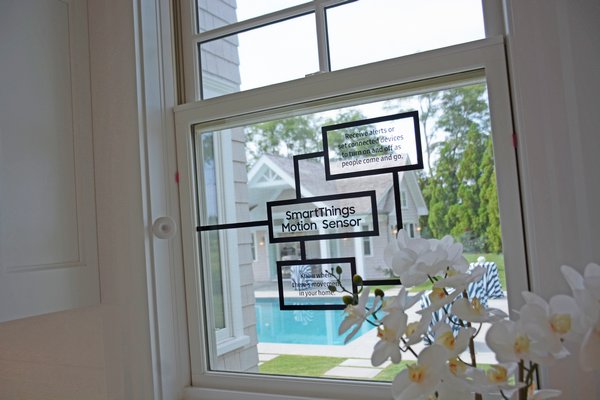
The subject of a weekend party in the Hamptons for advertising executives hosted by the marketing- and media-focused publication Ad Age was a new home—and all of the tricks it could do.
The festivities in August were in collaboration with the Internet of Things Consortium, an organization that jumpstarts business development opportunities for its members. During the event, the consortium discussed the growth in technologies revolutionizing the living room.
As David Beck, an executive vice president at Turner Broadcasting, said during a panel on how all of the different technologies can improve life at home: “It’s a complex, confusing thing and the consumer has challenges. We have to find what the customer wants and make it easy.”
Technology companies have sought to do just that, Mr. Beck said. But if a home was outfitted with every piece of new technology that could individually benefit a homeowner, he said it would “drive them nuts” instead.
Many of the new technologies featured in the Ad Age Hamptons House were smart technologies—those that are capable of adapting automatically based on the environment around them, using sensors.
The house at 475 David Whites Lane in Southampton—two stories, seven bedrooms and 6.5 baths on 1.8 acres—was crafted by Hamptons Luxury Estates LLC developer Yale Fishman with the thought in mind that a house needs to be built ready to adapt to new technologies.
“We build homes as if we are the homeowner and decide in the planning and development stages what is needed,” Mr. Fishman said. “It’s a lot more efficient and cost effective if I am building a home for it to be fully wired with video and television and internet, tapping into smart home technologies, if all of that is wired ahead of time, instead of giving a home that’s painted to a client who now has to rip up all of the walls.”
Mr. Fishman installed soundproofing wood flooring into the home to “add an extra level of comfort.” The home’s geothermal heating and central air conditioner, lighting, security and energy usage can be wired to be monitored and adjusted from a smartphone using Control4’s home automation systems, he added.
Before the panel discussion, Anthony Zirfas with Samsung SmartThings was in the kitchen showing off a few hidden smart products. The corner on top of the countertop was the SmartThings hub—a little white box no wider than a CD.
“It takes a lot of interactions in our daily life and combines them into one application,” Mr. Zirfas said. At home, people may have an array of technologies created by different companies. The hub can communicate with all of them from one central spot, including voice assistants like Amazon Alexa and Google Home, and with connected lights, locks and sensors.
“When you think about those interactions, they are all done through separate apps. I have an app for my lock. I have a different app for the lights. The hub takes all of these devices and combines them into one application on your smartphone.”
Samsung creates its own versions of popular sensors on the market for between $20 and $70. A multipurpose sensor—which is about the size of a book of matches—is attached to the outside of a wine cooler. It’s divided into two pieces that stay together with magnets. When the magnetic pull is broken by opening the cabinet door, it sends an alert to Mr. Zirfas’s phone, notifying him that someone has gotten into the wine stash. The multipurpose sensor can also detect things like temperature and vibrations as well.
“If you wanted to play a joke on someone at a party, you could have the lights change a different color when someone helps themselves to your wine,” he said.
Positioned on the floor below the wine cooler is a water-leak sensor.
“Should a leak spring up and something happens in an area that you are concerned about water damage, as soon as it hits water you’ll get a notification on your smartphone,” Mr. Zirfas said. “Think about flooding or frozen pipes bursting. That’s a real concern and you’ll know at work the moment it happens.”
Nestled in the corner is the smart outlet—a power brick that’s plugged into the standard wall outlet.
“It’s taking dumb appliances and making them smart,” he said. Appliances that can be left in the on position that are plugged into the brick can be turned off and back on again from a smartphone, by voice control connected with a smart assistant or a SmartThings button. The button can be programmed to, say, turn off the lights, close the garage door, lock the front door and lower the heat in the house all by a click on the way to work.
“We need to move away from our little white boxes because our parents are not buying—my friends are not even buying it,” said Abbie Byrom, the director of Global Partner Marketing of Samsung SmartThings, talking about what’s the next step for these products. “We need to skip that by embedding these technologies into products that already exist, that are already widely used, and that are needed.”
Ashwin Limaye, who’s a product manager at Google, said technology companies need to work together to create an optimal experience for homeowners with products that seamlessly work together and “think” three steps ahead.
“I think we can build a thoughtful home,” Mr. Limaye said.
For instance, a family decides after dinner they want to stream the next episode of the series they are hooked on—like they do every Monday night. The father tells his voice assistant, “Hey Alexa, it’s TV time,” and the lights dim, the microwave starts nuking popcorn and on turns the television to Netflix where the desired episode starts to play. Technology isn’t there quite yet, but it’s close.
“There is enough room in the living room for all companies to be involved,” he said. “The friction comes from who solves the problem first. Then it doesn’t and shouldn’t matter.”